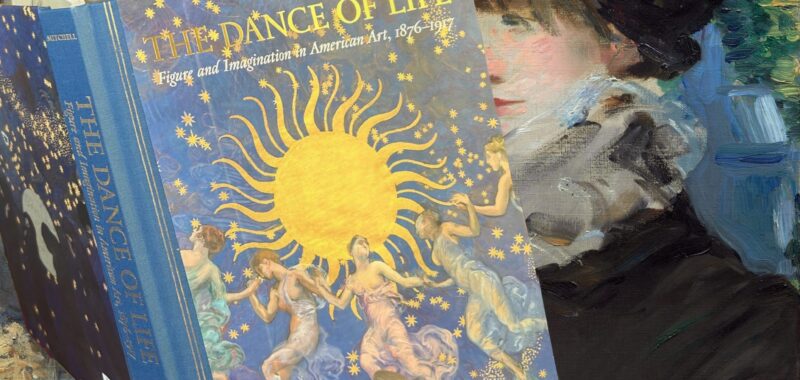I’ve said it before, and I’ll say it again: November is the Sunday of the year. And given the particularly intense Sunday scaries that have befallen us, we’re keeping our art-reading list short and sweet this time around, with what will hopefully act as fitting antidotes to a deluge of grim news. In art biographies, Julia Warhola (Andy Warhol’s mother) finally gets a scholarly exploration worthy of her multifaceted life, while a study of São Paulo’s Neo-Avant-Garde during the Brazilian dictatorship provides an energizing roadmap for bolstering social movements. We also bring you a round-up of new monographs and catalogs you’ll want to add to your collection, and perhaps your holiday wishlist … —Lakshmi Rivera Amin, Associate Editor

Hokusai by Andreas Marks
This voluminous book is arguably the most comprehensive study of Hokusai’s work to date. It packs an impressive volume of works from the deep well of the Japanese artist and printmaker’s long career, far beyond his omnipresent depictions of Mount Fuji. There’s an unending magic to Hokusai’s masterful “images of the floating world.” It’s a wondrous legacy well treated and handsomely packaged in this hefty monograph. —Hakim Bishara
Buy on Bookshop | Taschen, November 2024
Andy Warhol’s Mother: The Woman Behind the Artist by Elaine Rusinko

Andy Warhol is the stuff of Pittsburgh legend, ahead of even Heinz ketchup and bridges in my hometown’s claims to fame. I visited his namesake museum so many times as a child that I knew, intuitively, to head for the Silver Clouds to frolic among the inflated metallic balloons. But chief among his personal and artistic influences is a figure whose long-overdue biography will be published this month (by the University of Pittsburgh Press, no less): his mother, Julia Warhola. Following her life from her youth in present-day Slovakia to Pittsburgh to New York City, where she supported her son’s burgeoning artistic practice, scholar Elaine Rusinko offers a necessary corrective to narratives that either mention Warhola in passing or relegate her to the tired “women who made successful male artists’ careers possible” category. Rusinko sifted through letters and other archival material to bring her subject to life for readers: Warhola was a mentor, artist and calligrapher, devout Byzantine Catholic, and fierce advocate for her family and fellow immigrant community. She deserves a textured portrait worthy of her work and rich inner life, and this book finally grants it. —LA
Buy on Bookshop | University of Pittsburgh Press, November 2024
The São Paulo Neo-Avant-Garde: Radical Art and Mass Print Media in Cold War Brazil by Mari Rodríguez Binnie

During Brazil’s two-decade military dictatorship in the 1970s and ’80s, when the regime in power murdered, tortured, disappeared, and silenced dissidents, a group of artists in São Paulo devised techniques that allowed them to criticize authority while flying under the radar. They relied largely on photocopying, offset printing, and other mass print distribution strategies whose simplicity and accessibility belied their subversive potential — from Cildo Meireles’s interventions into conservative Brazilian newspapers via classified ads to Carmela Gross’s appropriation of rubber stamps to satirize bureaucracy. These are among the many such works discussed in The São Paulo Neo-Avant-Garde: Radical Art and Mass Print Media in Cold War Brazil, a timely book that will appeal to both researchers interested in this pivotal period of Latin American art history and anyone inspired by alternative methods of resistance as the specter of censorship grows more ominous with the rise of political authoritarianism worldwide. —Valentina Di Liscia
Buy on Bookshop | University of Texas Press, October 2024
Cézanne/Renoir: Masterpieces from the Musée de l’Orangerie and the Musée d’Orsay, edited by Cécile Girardeau and Stefano Zuffi

What did Paul Cézanne and Pierre-Auguste Renoir have in common? A lot! Though their styles were different, the two Impressionists shared a genuine friendship based on admiration of each other’s work, and their careers crossed paths in myriad ways, sometimes even painting the exact same landscape or subject. They also shared one more thing: art dealer Paul Guillaume, whose massive collection of masterpieces the two painters, now split between Paris’s Musée d’Orsay and Musée de l’Orangerie, is the subject of this book. A pleasurable read, the book illuminates lesser-known parallels and similarities between the two men that will make you see each in a new light. —HB
Buy on Bookshop | Skira, October 2024
The Dance of Life: Figure and Imagination in American Art, 1876–1917, edited by Mark D. Mitchell

The Hours, goddesses of seasons and time in Greek mythology, commune in a shimmering sky in a sumptuous circa-1909 oil study. Edwin Austin Abbey produced it in preparation for a larger mural, installed on the dome of the Pennsylvania State Capitol’s House of Representatives chamber after his death. This study (and all the contradictions it evokes) adorns the cover of The Dance of Life: Figure and Imagination in American Art, 1876–1917. The catalog accompanies a show at the Yale University Art Gallery comprising dozens of studies by artists responding to an era of political turmoil in the United States — sound familiar? — through figuration. Inviting us to consider our bodies as multifaceted sites of domination and labor, but also of self-expression, joy, and autonomy, this book sparks insights that are as urgent now as they were when the studies were first sketched. —LA
Buy on Bookshop | Yale University Art Gallery, distributed by Yale University Press, June 2024
New Monographs and Catalogs

